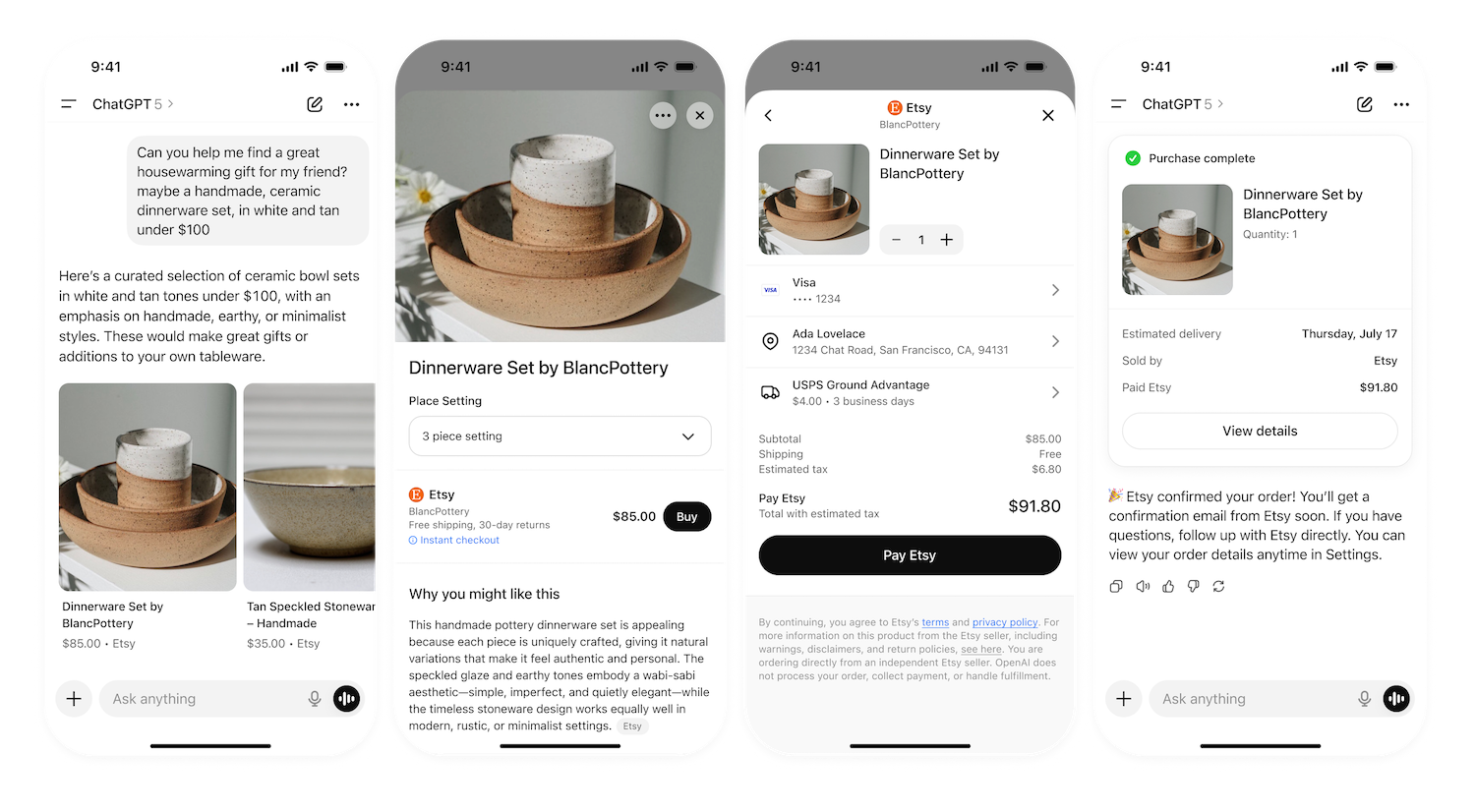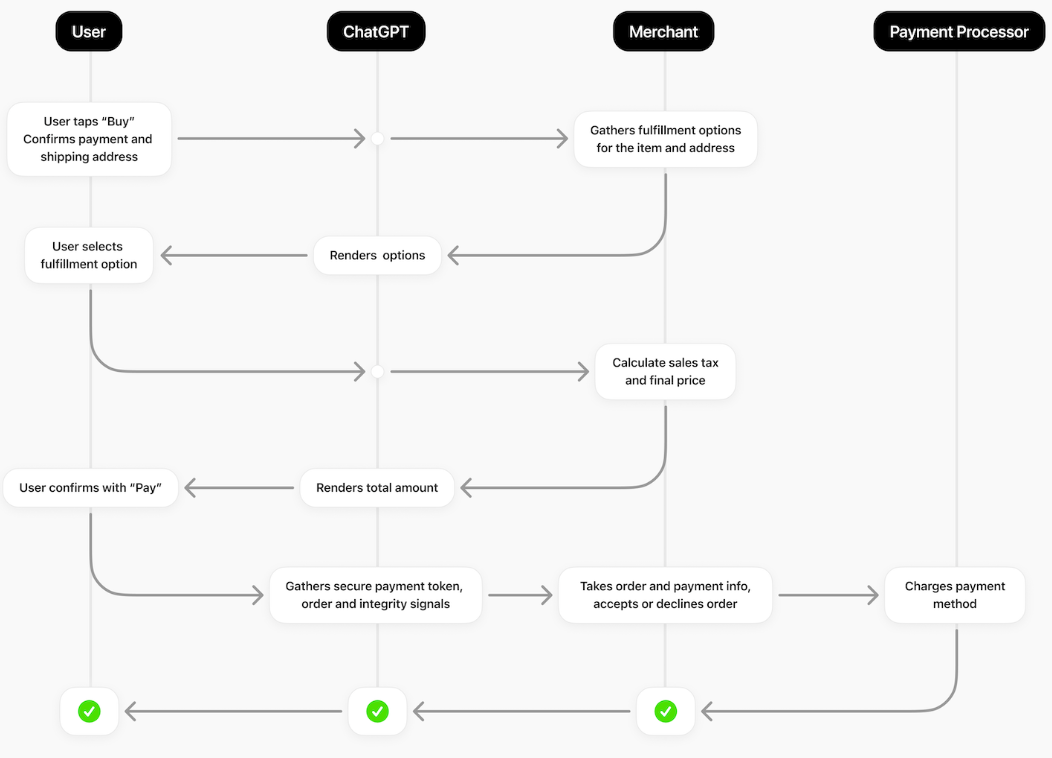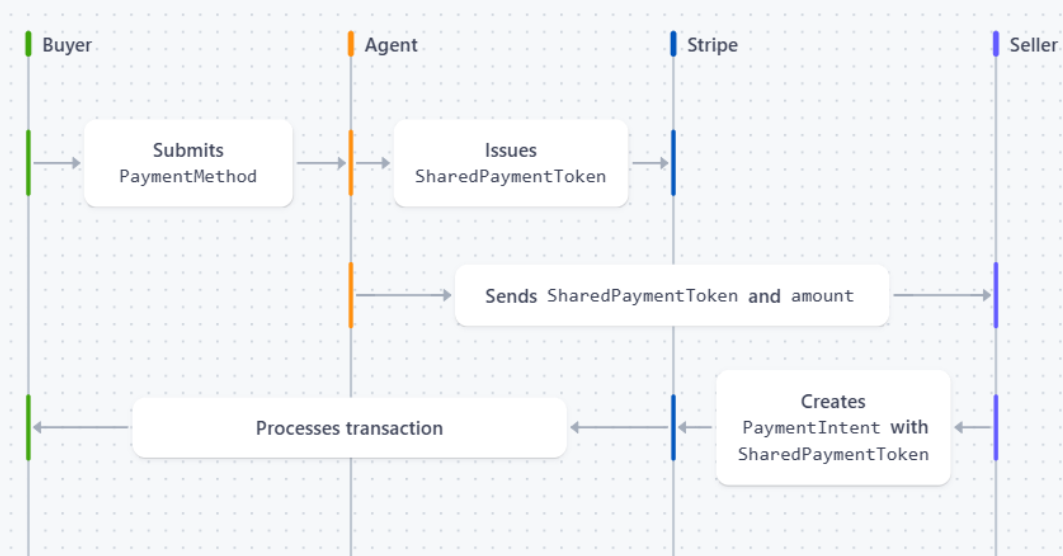How to Enable Instant Checkout in ChatGPT: A Practical Guide for Merchants


Conversational commerce is evolving rapidly, and OpenAI’s Agentic Commerce Protocol (ACP) now enables a fully integrated shopping experience within ChatGPT. Through ACP, merchants can connect their product catalogs, manage checkout sessions, and process payments—all directly within the chat interface.
This guide outlines how to enable instant checkout inside ChatGPT by implementing three key layers:
By following these steps, businesses can seamlessly integrate their online stores into ChatGPT’s commerce ecosystem and offer customers a frictionless, conversational purchasing experience.

The product feed is the foundation of the ChatGPT commerce integration. It provides accurate, structured data that the AI can use to identify, display, and manage products in response to user queries.
OpenAI defines a detailed Product Feed Specification that supports multiple formats, including TSV, CSV, JSON, and XML. Merchants should select the format best suited to their infrastructure while ensuring full compliance with OpenAI’s schema.
The product feed should include the following data categories:
Data freshness is critical: feeds should refresh at least every 15 minutes to ensure that price, availability, and promotions remain current.
This aligns with OpenAI’s refresh requirements for commerce partners.
Once a product is discoverable, ChatGPT’s AI agent can initiate and manage the transaction through the Agentic Checkout API, defined within the Agentic Commerce Protocol. This API establishes a standardized, secure way for merchants to communicate with ChatGPT during a purchase session.
Merchants must implement the following REST endpoints to handle the checkout lifecycle:
All endpoints should:
To ensure real-time consistency between the merchant and ChatGPT, two webhook events must be implemented:
Each webhook must be signed using an HMAC-based authentication scheme to verify its authenticity and integrity between systems.

The third layer of integration involves connecting to a payment service provider (PSP) through ACP’s Delegated Payment Specification. OpenAI and Stripe currently support delegated payments through the Stripe ACP implementation.
In this model, sensitive payment credentials are never exposed to ChatGPT or the merchant. Instead, the PSP handles storage, tokenization, and authorization securely, maintaining full compliance with PCI DSS Level 1 standards.
This delegated payment framework not only ensures compliance and security but also simplifies integration for merchants by centralizing payment management under a trusted provider such as Stripe.

A complete ChatGPT commerce integration typically follows a structured rollout plan:
At Rankwit, we help forward-thinking merchants prepare for the next evolution in digital commerce. Our team can design, develop, and deploy ChatGPT instant checkout integrations that fully comply with OpenAI’s Agentic Commerce Protocol—enabling your business to operate at the forefront of conversational AI.
While this technology is currently available only for U.S.-based e-commerce, early adopters have the opportunity to gain an unfair competitive advantage by being among the first to offer a fully AI-driven shopping experience.
If your e-commerce is built on Shopify or Etsy, you can already benefit from ChatGPT’s instant checkout without any additional integration effort.
However, if you operate a custom or enterprise-level platform, Rankwit can help you build the required infrastructure, from feed management to payment orchestration.
Partner with Rankwit.ai to future-proof your e-commerce operations and position your brand as a leader in the new era of conversational transactions.

At Rankwit, we specialize in helping merchants take advantage of OpenAI’s Agentic Commerce Protocol (ACP).
Our team manages the entire integration lifecycle—from mapping your product catalog to OpenAI’s structured feed specification, to building the checkout API endpoints and connecting secure payment providers like Stripe.
By partnering with Rankwit, your business can:
We tailor solutions to both enterprise and custom e-commerce platforms, ensuring a scalable and future-ready architecture.
ChatGPT Instant Checkout is a new capability since 2025 developed by OpenAI that allows users to discover, configure, and purchase products directly within ChatGPT—without leaving the conversation.
This functionality is powered by the Agentic Commerce Protocol (ACP), an open standard that defines how merchants’ systems interact with AI agents.
Merchants connect their product catalog through a structured product feed, expose checkout endpoints via the Agentic Checkout API, and process payments securely through delegated payment providers like Stripe.
Together, these layers create a smooth, conversational shopping experience that merges AI discovery with secure e-commerce execution.
As of now, ChatGPT Instant Checkout is available only for merchants operating in the United States.
If your online store runs on Shopify or Etsy, you can already take advantage of this feature without any additional implementation, since these platforms are directly supported by OpenAI’s infrastructure.
For custom-built or enterprise e-commerce systems, a dedicated integration following the Agentic Commerce Protocol (ACP) is required.
Rankwit can assist your team in developing this integration—allowing you to access the U.S. market immediately and prepare for future international expansion as OpenAI rolls out the program globally.
RankWit continuously scans generative AI engines like ChatGPT, Gemini, and Perplexity to see if, when, and how your content is referenced. We then aggregate this data into an easy-to-read dashboard, showing:
Large Language Models (LLMs) are AI systems trained on massive amounts of text data, from websites to books, to understand and generate language.
They use deep learning algorithms, specifically transformer architectures, to model the structure and meaning of language.
LLMs don't "know" facts in the way humans do. Instead, they predict the next word in a sequence using probabilities, based on the context of everything that came before it. This ability enables them to produce fluent and relevant responses across countless topics.
For a deeper look at the mechanics, check out our full blog post: How Large Language Models Work.